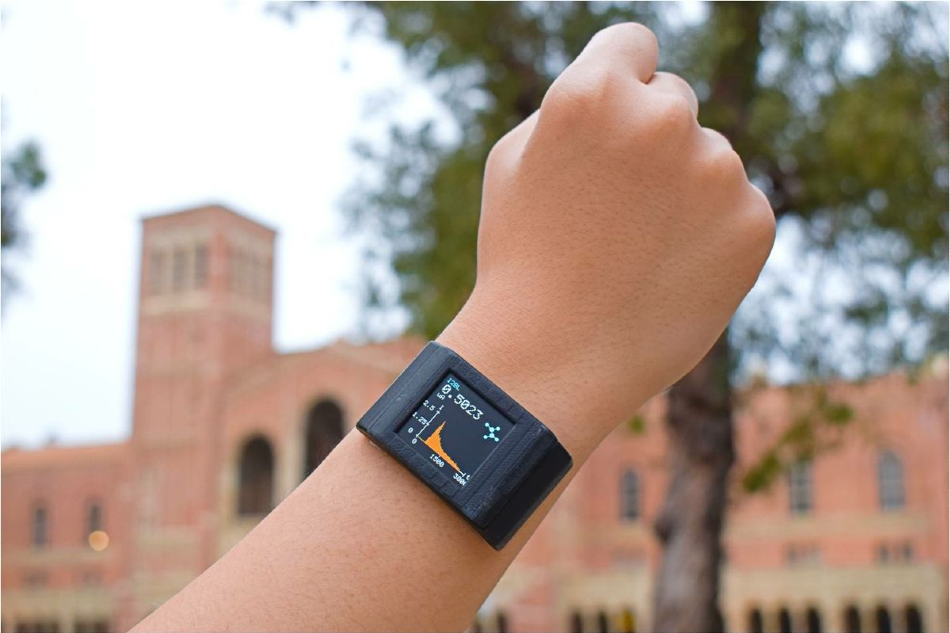Jun 18 2020
Engineers from the University of California, Los Angeles (UCLA) have developed a thin adhesive film that could turn a consumer smartwatch into a robust health monitoring system.
 The underside of this custom-built smartwatch contains a double-sided adhesive that can detect metabolites and nutrients present in body sweat. Image Credit: Yichao Zhao/University of California, Los Angeles.
The underside of this custom-built smartwatch contains a double-sided adhesive that can detect metabolites and nutrients present in body sweat. Image Credit: Yichao Zhao/University of California, Los Angeles.
By searching for chemical indicators found in sweat, the system effectively provides a real-time picture of what is actually occurring within the body. A study describing this novel technology was published in the Science Advances journal.
It is already known that smartwatches can help people to keep track of their walking distance, how much they have slept, and the rate of their heartbeats. There are emerging models that even show the potential to track blood pressure.
Working with various devices, including a tethered smartphone, someone can make use of a smartwatch to continuously monitor those health indicators across an extended period of time.
But these smartwatches are incapable of monitoring individuals’ body chemistry. To achieve that, the smartwatches must monitor biomarker molecules that are found in the body’s fluids. These biomarkers are highly specific indicators of people’s health, such as lactate and glucose, which indicate the status of their body’s metabolic condition.
To deal with that requirement, the scientists designed a disposable, double-sided adhesive film that binds to the underside of a smartwatch. This film can identify molecules such as metabolites and specific nutrients that are present in trace amounts in the body’s sweat. The researchers also developed a customized smartwatch and an associated app to capture data.
The inspiration for this work came from recognizing that we already have more than 100 million smartwatches and other wearable tech sold worldwide that have powerful data-collection, computation and transmission capabilities.
Sam Emaminejad, Study Lead and Assistant Professor, Electrical and Computer Engineering, Henry Samueli School of Engineering, University of California, Los Angeles
Emaminejad continued, “Now we have come up with a solution to upgrade these wearables into health monitoring platforms, enabling them to measure molecular-level information so that they give us a much deeper understanding of what’s happening inside our body in real time.”
The skin-contacting side of the thin adhesive film collects and examines the chemical composition of the droplets of sweat. The watch-facing side of the adhesive film converts those chemical signals into electrical ones. These electrical signals can be read, processed, and subsequently shown on the smartwatch.
Graduate student Yichao Zhao and postdoctoral scholar Bo Wang are co-lead authors of the study. Both Zhao and Wang are members of Emaminejad’s Interconnected and Integrated Bioelectronics Lab based at UCLA.
By making our sensors on a double-sided adhesive and vertically conductive film, we eliminated the need for the external connectors. In this way, not only have we made it easier to integrate sensors with consumer electronics, but we’ve also eliminated the effect of a user’s motion that can interfere with the chemical data collection.
Yichao Zhao, Study Co-Lead Author and Graduate Student, Interconnected and Integrated Bioelectronics Lab, University of California, Los Angeles
“By incorporating appropriate enzymatic-sensing layers in the film, we specifically targeted glucose and lactate, which indicate body metabolism levels, and nutrients such as choline,” stated Wang.
While the researchers developed a customized smartwatch and app to function with the system, Wang stated that the idea might one day be applied to well-known models of smartwatches.
The scientists tested the adhesive film on people who were sedentary or doing office tasks, and also those engaged in intense activities such as boxing. They subsequently observed that the system was effective in various situations.
The scientists also observed that the stickiness of the adhesive film was adequate for it to remain fixed on the watch and on the skin without requiring a wrist strap for a whole day.
In the past several years, Emaminejad has headed studies relating to the use of wearable technology to identify indicator molecules via sweat. This latest research now shows that technologies of those kinds could be implemented extensively.
We are particularly excited about our technology because by transforming our smartwatches and wearable tech into biomonitoring platforms, we could capture multidimensional, longitudinal and physiologically relevant datasets at an unprecedented scale, basically across hundreds of millions of people. This thin sensing film that works with a watch shows such a path forward.
Sam Emaminejad, Study Lead and Assistant Professor, Electrical and Computer Engineering, Henry Samueli School of Engineering, University of California, Los Angeles
The other study authors, all from Emaminejad’s laboratory, include Hannaneh Hojaiji, Zhaoqing Wang, Shuyu Lin, Christopher Yeung, Haisong Lin, Peterson Nguyen, Kaili Chiu, Kamyar Salahi, Xuanbing Cheng, Jiawei Tan, and Betto Alcitlali Cerrillos.
The devices were built at UCLA with support from staff members at the Center for Minimally Invasive Therapeutics, the Nanoelectronics Research Facility, and UCLA Library’s Lux Lab.
The study was funded by the National Science Foundation, a Stanford Genome Technology Center Distinguished Young Investigator Award (with Intermountain Healthcare), the Henry M. Jackson Foundation, the PhRMA Foundation, and the Brain and Behavior Foundation, via its NARSAD Young Investigator Grant
A patent on this new technology has been applied by UCLA.
Journal Reference:
Zhao, Y., et al. (2020) A wearable freestanding electrochemical sensing system. Science Advances. doi.org/10.1126/sciadv.aaz0007.